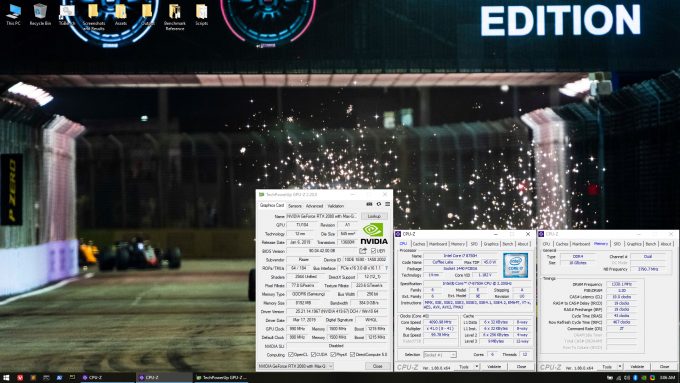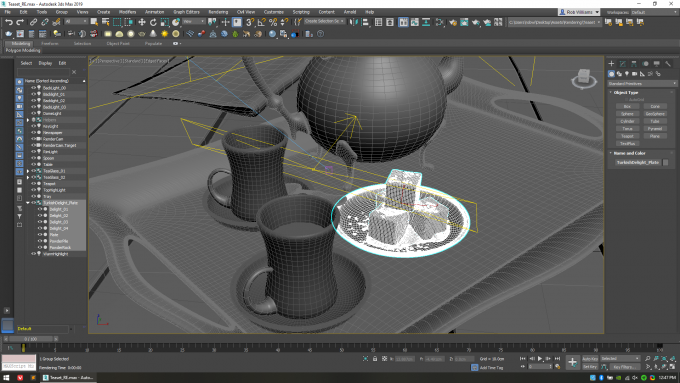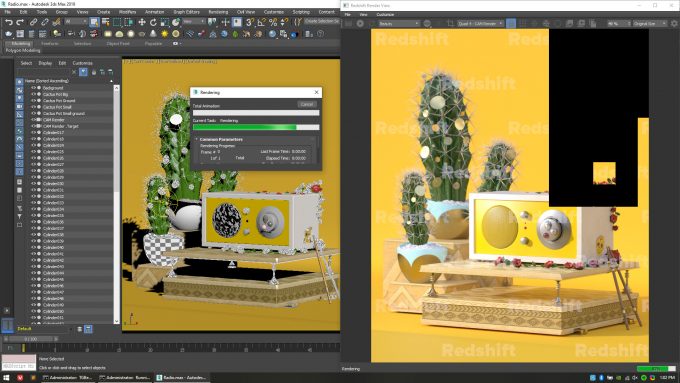- Qualcomm Launches Snapdragon 4 Gen 2 Mobile Platform
- AMD Launches Ryzen PRO 7000 Series Mobile & Desktop Platform
- Intel Launches Sleek Single-Slot Arc Pro A60 Workstation Graphics Card
- NVIDIA Announces Latest Ada Lovelace Additions: GeForce RTX 4060 Ti & RTX 4060
- Maxon Redshift With AMD Radeon GPU Rendering Support Now Available
Getting Creative Work Done With The Razer Blade 15 & GeForce RTX 2080 Max-Q

There’s a lot more that can be done with a gaming GPU than just the obvious. Today’s GPUs are highly tuned for creator workloads, such as 3D design, rendering, and of course, encoding. We’re taking a look at the latest Razer Blade 15, equipped with NVIDIA’s GeForce RTX 2080 Max-Q, to see how it handles real workloads.
Page 2 – Gaming & Pro Graphics Performance
When we first sat down with the Razer Blade 15, we didn’t expect to put as much time into benchmarking as we did. But, this is an interesting notebook, and it’s the first gaming notebook we’ve received for testing in quite some time, and not to mention the first one we’ve tested for workstation use.
Razer also adds some variability to testing thanks to its inclusion of additional performance modes. Most notebook vendors would scoff at the idea of letting people boost their CPU or GPU clocks, or allow full manual control of the fan, but not Razer.
The default profile is “Balanced”, which is in effect the mode chosen even if you haven’t signed into the Synapse software. The Gaming profile boosts GPU, while the Creator mode boosts CPU. While both of these will ramp the fans up high under heavy load, we also manually cranked the fan to 100% with the Gaming mode to see how performance could improve further.
Let’s start with a look at some of the most important performance there is for creators: viewport. Unless you are under a really tight deadline, longer render times might not matter too much, but when it comes to the performance of the viewport you actually work inside to create your project, you’re going to notice when you’re missing out on smooth frames.
| RTX 2080 Max-Q Viewport Performance | ||||
| Balanced | Creator | Gaming | 100% Fan | |
| 3ds Max | 175 | 166 | 175 | 175 |
| CATIA | 124 | 120 | 126 | 128 |
| Creo | 162 | 155 | 164 | 166 |
| Maya | 207 | 202 | 212 | 215 |
| Siemens NX | 20 | 20 | 20 | 20 |
| SolidWorks | 73 | 73 | 74 | 74 |
| Blender 2.8 LookDev | 65 FPS | 62 FPS | 67 FPS | 67 FPS |
| Notes | Higher is better. All reflect “scores”, except Blender. 100% fan test uses Gaming profile. |
|||
It’s clear from the get-go that the Creator mode isn’t ideal if you’re doing graphics work, but that’s exactly what we should expect. Creator mode would be useful for encoding scenarios, but only if the GPU isn’t used that heavily, which is often the case.
What these results also prove is that there isn’t a significant difference between the Balanced and Gaming modes, even if the fan is cranked to 100%. This is a great thing, because 1- It means you are not going to miss out on real performance due to heat, and 2- Running any fan at 100% over the long-run probably isn’t ideal for its lifespan.
But here’s where things get a little interesting for the Gaming profile:
| RTX 2080 Max-Q Gaming Performance | ||||
| Balanced | Creator | Gaming | 100% Fan | |
| Fire Strike 1080p | 16,844 | 16,371 | 17,344 | 18,027 |
| Time Spy Extreme 4K | 3,223 | 3,196 | 3,318 | 3,385 |
| Superposition 1080p | 4,846 | 4,401 | 4,869 | 4,996 |
| Superposition 4K | 6,400 | 5,773 | 6,413 | 6,588 |
| VRMark Blue Room | 53 FPS | 48 FPS | 53 FPS | 54 FPS |
| Notes | Higher is better. 100% fan test uses Gaming profile. Fire Strike and Time Spy results are Overall scores. |
|||
Viewport performance didn’t give us great proof that the Gaming profile will make a notable difference, but actual gaming is different. Here, a 3% performance boost could be seen in gaming when running the appropriate profile, but this is a case where we can see heat can get in the way. Using 100% fan speeds increased that 3% improvement to 7%.
In the grand scheme, the performance improvements are obvious on paper, but they’re going to be less so in the real-world. Still, a 7% difference between stock and the Gaming + 100% Fan profile is an impressive one.
What about for rendering?
| RTX 2080 Max-Q Render Performance | ||||
| Balanced | Creator | Gaming | 100% Fan | |
| LuxMark – Hotel | 5,143 | 4,982 | 5,184 | 5,189 |
| LuxMark – LuxBall | 21,876 | 21,675 | 21,861 | 21,956 |
| OctaneBench – RTX Off | 157 | 149 | 155 | 156 |
| OctaneBench – RTX On | 458 | 453 | 459 | 462 |
| Notes | Higher is better. 100% fan test uses Gaming profile. |
|||
| RTX 2080 Max-Q Render Performance | ||||
| Balanced | Creator | Gaming | 100% Fan | |
| Arnold GPU – E-Type | 254 s | 255 s | 255 s | 254 s |
| Blender – BMW | 93 s | 93 s | 92 s | 92 s |
| Blender – Classroom | 133 s | 134 s | 133 s | 132 s |
| Blender – Eevee | 82 s | 89 s | 82 s | 80 s |
| ProRender – GT-R | 164 s | 172 s | 162 s | 161 s |
| ProRender – Villa | 95 s | 102 s | 94 s | 94 s |
| Redshift – Radio | 145 s | 149 s | 145 s | 143 s |
| Notes | Lower is better. 100% fan test uses Gaming profile. |
|||
When we talked to NVIDIA about running all of our benchmarks with 100% fan speed, we were told not to expect any differences in rendering, but probably in gaming. Lo and behold, that’s exactly what we’re finding here. There is absolutely no reason to worry about any of the profiles for rendering work. You just don’t want to be using the Creator mode, since it could actually reduce the performance you’re wanting.
This is actually the kind of result we want to see, because it’d make us uneasy to see a huge gain with 100% fan speed, and in the next breath tell people to not use it for prolonged periods of time. Razer does give the option, so it’s clearly supported, but, fans are not exactly the most durable products on earth. And… if it makes no difference in rendering and viewport performance, the extra wear is pointless for ProViz.
It’s well-established at this point that the stock configuration is great as-is for professional work, despite the fact that the laptop can get quite warm under stress (we measured 45°C above the keyboard; hot, but not hot enough to burn). There are other considerations to bear in mind, though, such as how performance could be impacted when using an external monitor. Let’s divulge:
| RTX 2080 Max-Q Viewport Performance | ||||
| Notebook Monitor | External (Duplicated) | External (Only) | External (100% Fan) | |
| 3ds Max | 175 | 159 | 187 | 190 |
| CATIA | 124 | 114 | 133 | 135 |
| Creo | 162 | 150 | 184 | 190 |
| Maya | 207 | 189 | 260 | 273 |
| Siemens NX | 20 | 19 | 21 | 21 |
| SolidWorks | 73 | 70 | 92 | 93 |
| Notes | Higher is better. | |||
This table takes the cake for offering us the most interesting results on this page. When plugging in an external monitor, graphics performance improves across-the-board, to a fairly significant degree in some cases. We’re talking a bump from 207 to 260 points in Maya by simply using only an external monitor.
After talking to NVIDIA about these findings, we were told this is expected behavior, and a byproduct of how Windows manages Optimus. This is unfortunate if you never plan to do work on an external monitor, but there is an upside. This mechanic seems to mostly impact viewport tests. Our gaming tests didn’t show the same kind of gain, and instead showed a slight decline in some cases.
This leads us to another point. This notebook includes two GPUs, and on rarer occasions, Intel’s integrated graphics will treated as the primary. Interestingly, some applications don’t seem to care that two GPUs exist, like LuxMark, but others do, such as MAGIX Vegas Pro (benched later). Long story short, if your workstation application seems slow, make sure it is using the correct GPU.
As for the screen duplication causing such degradation, it’s because it causes additional PCIe transfers that bog things down – something that doesn’t happen when extending the display instead (using external as primary, notebook as secondary).
It’s not entirely fair to compare a notebook GPU to a discrete one for desktop, but it’s important to have an understanding of how performance differs between them. If you are a dedicated mobile warrior, then improved desktop performance isn’t going to mean a thing. But if you are trying to decide between a notebook or a desktop, this could help.
| RTX 2080 Max-Q Comparative Performance | ||||
| GeForce RTX 2080 Max-Q | GeForce RTX 2060 Desktop | Quadro RTX 4000 Desktop | Radeon Pro WX 8200 Desktop | |
| Fire Strike 1080p | 20,189 | 18,432 | 19,989 | 19,041 |
| Time Spy Extreme 4K | 3,510 | 3,392 | 3,565 | 2,972 |
| VRMark Blue Room | 53 | 51 | 52 | 39 |
| Blender LookDev | 67 FPS | 53 FPS | 63 FPS | 42 FPS |
| 3ds Max | 175 | 184 | 198 | 152 |
| Maya | 212 | 252 | 281 | 248 |
| Octane – RTX Off | 155 | 156 | 172 | N/A |
| Octane – RTX On | 459 | 457 | 559 | N/A |
| Sandra – Cryptography | 46 GB/s | 53 GB/s | 55 GB/s | 91 GB/s |
| Sandra – Financial | 3.71 TFLOPS | 3.36 TFLOPS | 3.33 TFLOPS | 2.91 TFLOPS |
| Sandra – Scientific | 1.22 TFLOPS | 1 TFLOPS | 1.12 TFLOPS | 1.15 TFLOPS |
| Notes | Higher is better. Fire Strike and Time Spy results are Graphics scores. |
|||
| RTX 2080 Max-Q Comparative Performance | ||||
| GeForce RTX 2080 Max-Q | GeForce RTX 2060 Desktop | Quadro RTX 4000 Desktop | Radeon Pro WX 8200 Desktop | |
| ProRender – GT-R | 164 s | 172 s | 162 s | 161 s |
| Redshift – Radio | 145 s | 161 s | 145 s | N/A |
| Vegas Pro – LUT | 313 s | 287 s | 287 s | 279 s |
| Vegas Pro – Median | 121 s | 125 s | 118 s | 118 s |
| Notes | Lower is better. | |||
Overall, it feels like the RTX 2080 Max-Q is most comparable to the desktop’s GeForce RTX 2060, with both trading strengths throughout. Ultimately, the Max-Q comes ahead in that battle, and while we’re not seeing performance on the level of a desktop RTX 2080, the 2060 has been one of our most-recommended “creator” GPUs lately, so it’s good to see that level of performance here.
While the tested Max-Q GPU shares similar specs with its desktop counterpart, clock speeds are largely what hold it back – they’re significantly higher on desktop. The RTX 2080 Max-Q peaks at 1,215MHz, whereas the desktop version peaks at 1,710MHz. The performance delivered by the Max-Q is impressive for its power envelope; it’s spec’d as an 80W TDP chip, while the desktop variant is 215W.
Support our efforts! With ad revenue at an all-time low for written websites, we're relying more than ever on reader support to help us continue putting so much effort into this type of content. You can support us by becoming a Patron, or by using our Amazon shopping affiliate links listed through our articles. Thanks for your support!









